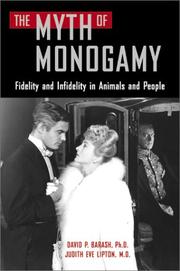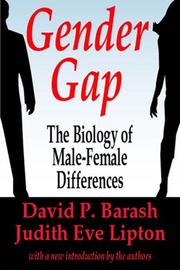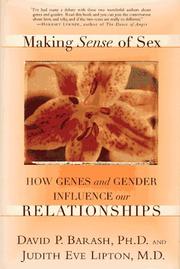| Listing 1 - 7 of 7 |
Sort by
|
Multi
ISBN: 9780231518390 9780231146654 Year: 2009 Publisher: New York, N.Y. Columbia University Press
Abstract | Keywords | Export | Availability | Bookmark
 Loading...
Loading...Choose an application
- Reference Manager
- EndNote
- RefWorks (Direct export to RefWorks)

ISBN: 0716740044 Year: 2001 Publisher: New York : W. H. Freeman and Co.,
Abstract | Keywords | Export | Availability | Bookmark
 Loading...
Loading...Choose an application
- Reference Manager
- EndNote
- RefWorks (Direct export to RefWorks)
Sociology of the family. Sociology of sexuality --- Animal ethology and ecology. Sociobiology --- Adultery. --- Sex customs. --- Sexual behavior in animals. --- 392.6 --- Animals --- Breeding behavior --- Copulation behavior in animals --- Copulation in animals --- Copulatory behavior in animals --- Copulatory pattern (Animal behavior) --- Mating behavior --- Reproductive behavior --- Sex behavior in animals --- Animal behavior --- Customs, Sex --- Human beings --- Sexual behavior --- Sexual practices --- Manners and customs --- Moral conditions --- Sex --- Adulterous relationships --- Cheating, Marital --- Extra-marital sex --- Extramarital sex --- Infidelity, Marital --- Marital cheating --- Marital infidelity --- Marriage --- Sex crimes --- Paramours --- Seksualiteit. Seksueel leven. Concubinaat. Samenwonen. Prostitutie. Erotiek. Seksuele gebruiken. Liefdeskunst --- 392.6 Seksualiteit. Seksueel leven. Concubinaat. Samenwonen. Prostitutie. Erotiek. Seksuele gebruiken. Liefdeskunst --- Adultery --- Sex customs --- Sexual behavior in animals
Book
ISBN: 9780231146647 0231146647 9780231518390 0231518390 1282796461 9786612796463 Year: 2009 Publisher: New York (N.Y.) : Columbia university press,
Abstract | Keywords | Export | Availability | Bookmark
 Loading...
Loading...Choose an application
- Reference Manager
- EndNote
- RefWorks (Direct export to RefWorks)
So how did women get their curves? Why do they have breasts, while other mammals only develop breast tissue while lactating, and why do women menstruate, when virtually no other beings do so? What are the reasons for female orgasm? Why are human females kept in the dark about their own time of ovulation and maximum fertility, and why are they the only animals to experience menopause?David P. Barash and Judith Eve Lipton, coauthors of acclaimed books on human sexuality and gender, discuss the theories scientists have advanced to explain these evolutionary enigmas (sometimes called "Just-So stories" by their detractors) and present hypotheses of their own. Some scientific theories are based on legitimate empirical data, while others are pure speculation. Barash and Lipton distinguish between what is solid and what remains uncertain, skillfully incorporating their expert knowledge of biology, psychology, animal behavior, anthropology, and human sexuality into their entertaining critiques. Inviting readers to examine the evidence and draw their own conclusions, Barash and Lipton tell an evolutionary suspense story that captures the excitement and thrill of true scientific detection.
Women --- Evolution. --- Human evolution

ISBN: 0765808862 Year: 2002 Publisher: New Brunswick Transaction
Abstract | Keywords | Export | Availability | Bookmark
 Loading...
Loading...Choose an application
- Reference Manager
- EndNote
- RefWorks (Direct export to RefWorks)
Human evolution. --- Sex (Biology) --- Sex differences. --- Sex. --- Social evolution. --- Evolution. --- Human evolution --- Sex --- Sex differences --- Social evolution --- 305 --- Cultural evolution --- Cultural transformation --- Culture, Evolution of --- Culture --- Evolution --- Social change --- Gender differences --- Sexual dimorphism in humans --- Sex differentiation --- Sex (Physiology) --- Biology --- Gender (Sex) --- Human beings --- Human sexuality --- Sex (Gender) --- Sexual behavior --- Sexual practices --- Sexuality --- Sexology --- Evolution (Biology) --- Physical anthropology --- Evolutionary psychology --- 305 Genderstudies. Rol van de sekse. Gender. Personen vanuit interdisciplinair gezichtspunt --- Genderstudies. Rol van de sekse. Gender. Personen vanuit interdisciplinair gezichtspunt --- Physiological aspects --- Origin

ISBN: 1559634529 Year: 1997 Publisher: Washington (D.C.) : Island press,
Abstract | Keywords | Export | Availability | Bookmark
 Loading...
Loading...Choose an application
- Reference Manager
- EndNote
- RefWorks (Direct export to RefWorks)
Human evolution. --- Sex (Biology) --- Sex differences. --- Sex. --- Social evolution. --- Evolution.
Book
ISBN: 0199752982 0190255765 1283058715 9786613058713 0199753210 9780199753215 019539514X 9780195395143 Year: 2011 Publisher: New York, N.Y. : Oxford University Press,
Abstract | Keywords | Export | Availability | Bookmark
 Loading...
Loading...Choose an application
- Reference Manager
- EndNote
- RefWorks (Direct export to RefWorks)
From the child taunted by her playmates to the office worker who feels stifled in his daily routine, people frequently take out their pain and anger on others, even those who had nothing to do with the original stress. The bullied child may kick her puppy, the stifled worker yells at his children: Payback can be directed anywhere, sometimes at inanimate things, animals, or other people. In Payback, the husband-and wife team of evolutionary biologist David Barash and psychiatrist Judith Lipton offer an illuminating look at this phenomenon, showing how it has evolved, why it occurs, and what we
Pain. --- Revenge. --- Aggressiveness.
Book
ISBN: 0394624335 Year: 1982 Publisher: New York Grove Press
Abstract | Keywords | Export | Availability | Bookmark
 Loading...
Loading...Choose an application
- Reference Manager
- EndNote
- RefWorks (Direct export to RefWorks)
First part of this book is a practical, step-by-step guide to the variety of ways in which each of us can cast his vote for survival: how to write and telephone politicians, hold meetings... In the second part of this book the authors describe several cases of how a nuclear war might start. They describe the immediate effects of a nuclear explosion. They criticizes the civil defence myths. Includes list of peace organizations in the US.
| Listing 1 - 7 of 7 |
Sort by
|

 Search
Search Feedback
Feedback About UniCat
About UniCat  Help
Help News
News